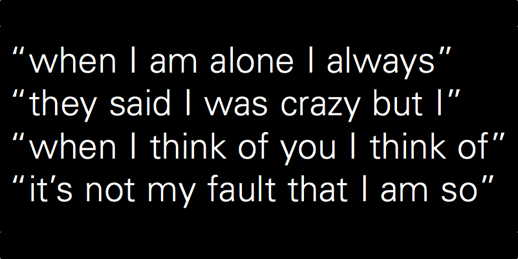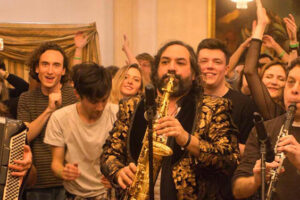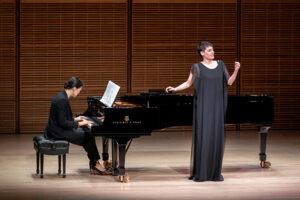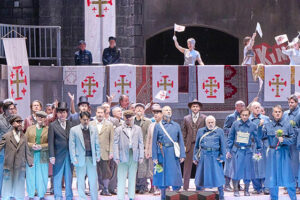

When everyone had taken their seat, there must have been 48 of us in these little recesses like orchestra pits (audience pits?), one row of seven like mine plus a perpendicular row of five for each fourth of the space, and the instrumentalists took their places on the tiny stage built upon the stage of what was already a small black-box theater.
Hanging over the heads of the listeners sitting just to my left was a great bass drum; over the row perpendicular to us was a suspended cymbal, and this setup was repeated on the other two visible quarters of the stage. The four performers—the International Contemporary Ensemble’s cellist Kivie Cahn-Lipman, flautist Claire Chase, clarinetist Joshua Rubin, and percussionist Ross Karre—each kneeled and began adjusting a cymbal, manipulating it carefully with their fingers, and when they began whispering we realized that the music had already begun. The first “note” was that sound of the cymbal not being struck or even stroked, just touched.
The text of David Lang‘s the whisper opera was (Lang has said) generated procedurally, by entering one of four sentence fragments into Google:
when I am alone I always
they said I was crazy but I
when I think of you I think of
it’s not my fault that I am so
…and setting the most interesting results to complete each sentence—sort of like John Supko’s lovely This Window Makes Me Feel, which sets a long Google poem of the same name by Robert Fitterman.
The resulting text was poignant, funny, intimate, and secret: no excerpts were printed in the program. Lang’s score specifies that no recordings are to be made of the opera, that it is not to be amplified, and that it is to be performed for an audience only one row deep—as an exploration of barely perceptible musical phenomena, it only can be realized by a very, very intimate live performance.
In its New York premiere at least, directed and designed by Jim Findlay, the whisper opera was not just about the nearly inaudible, but also about the invisible and nearly invisible. Soprano Tony Arnold was at first heard and not seen, crooning a simple melody somewhere outside the veils bounding the stage after the other performers had already begun to play. The instrumentalists also left the stage, or moved between its four chambers, as the score required, so that the dozen of us watching were at some point alone with most of the players (Chase I only spied in the next quarter), walking on in their socks so that their steps would be nearly soundless, reading their music from iPads to prevent the sound of page-turns, and playing their instruments as softly as possible. Karre, for instance, played his glockenspiel with the tips of his fingers. Lang’s score was sparing in its use of pitched melodies and harmonies, shuffling between only a handful of notes at a time in thin, highly repetitive textures, but he did pick the right pitches, and his textural procedures, often only loosely synchronized between the separated performers, were highly engaging—even, I’d discover, mesmerizing.
I know I lost it pretty quickly. Oh, I thought at one point, they’re playing a recording of the ocean. It’s must be the sound of the waves, crashing against a ship at sea. In the background of the music, I could hear the ship’s timbers creaking, the roar of the ocean waves, and perhaps some soft thunder off in the distance, and for several seconds, I listened closely to the sound of the ocean, and then only when some element of the music changed did I realize that I was being completely insane. There was no recording. There was no ocean. I had been listening to a pair (I think) of performers drag their fingernails across the heads of two bass drums and hallucinated the rest. I had even seen a performer demonstrate exactly the same drum technique in front of my eyes just moments earlier!
The score, in other words, was literally hypnotic—towards the end of the hour, I found myself falling into trance after trance, triggered by a change in the music or the lighting into realizing that I had been in the middle of a strange dream and then, horrified that I’d fallen asleep during the performance, only to realize that my eyes had never closed, that in fact they were starting to feel dry from staring straight ahead while I had tried to listen as closely as I could to the sounds being made behind and around me.
The part for Arnold, whose recordings of Messiaen and Kurtág have proved her an expressive and precise interpreter of highly challenging scores, was whispered far more often than sung and, when sung, seemingly quite simple—they certainly gave her no difficulty. But the score’s burden was nevertheless immense, calling for her to pace from one area to another hissing strings of decontextualized sentence fragments with full dramatic commitment—like a ghostly character in a Beckett play—and even, at one point, to stand in the center of the stage and manually cue the separated instrumentalists like a conductor. It was an utterly convincing performance, a “star turn” even surrounded by performers who were hardly less charismatic or dramatically acute in the execution of their unusually theatrical parts. I would have expected no less from ICE, which makes it their business to inhabit and embody impossibly fragile works like this.
At the end of the piece, the lights dimmed to nothing, and the players switched off their iPads. The spell was unbroken by the applause; I left the hall still under a trance. I grabbed a beer at the reception down the hall and tried to make lame conversation, but I could barely speak. I left not long after the bottle was empty and headed to my train alone.























Comments